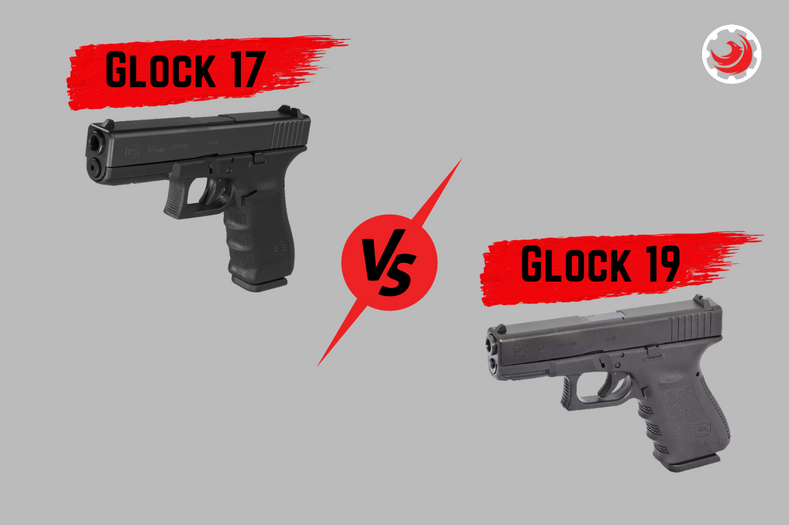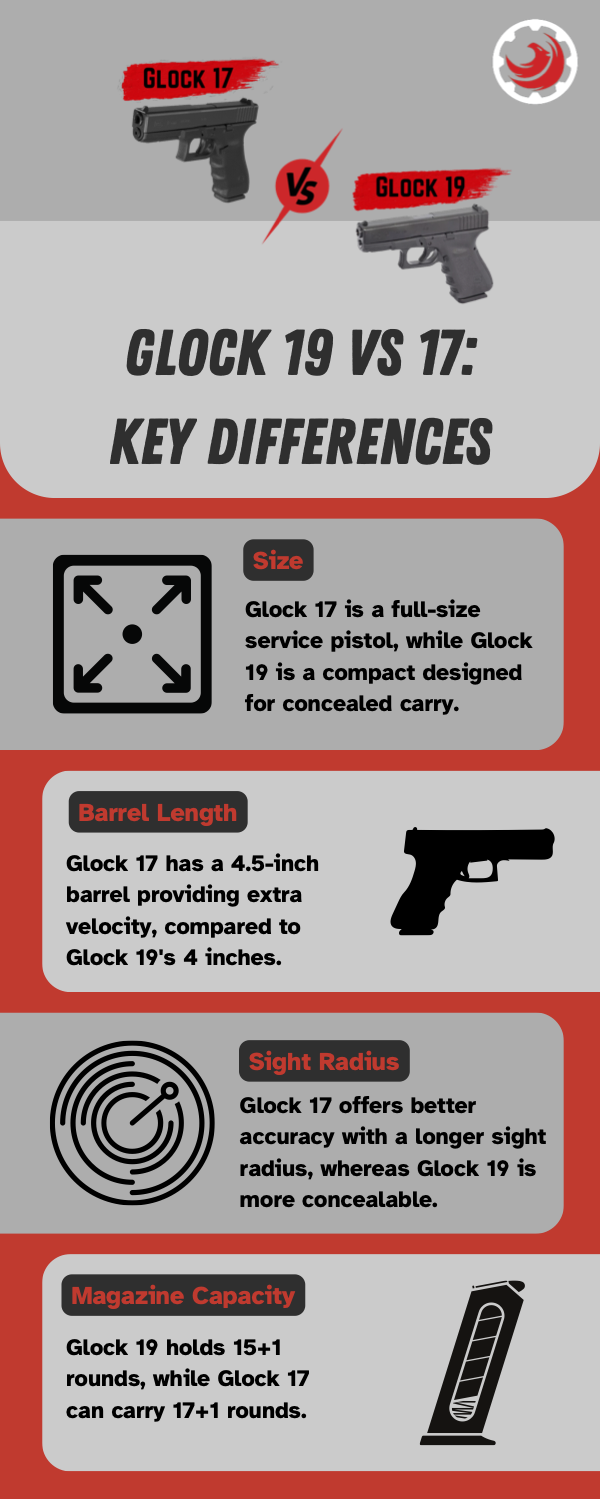Glock 19 vs 17: Handgun Comparison

Glock is probably the single most iconic pistol brand in the United States, finding use amongst thousands of law enforcement agencies across the country. And it doesn’t just pertain to law enforcement; Glock handguns are also extremely popular with gun owners and for EDC. Their widespread use stems from their peerless reputation for reliability, and Glocks have become the standard by which other pistols are judged.
The full-size Glock 17 and the compact Glock 19 are two such pistols. While the Glock 17 is the premier pistol for uniformed American law enforcement, the Glock 19 is not far behind and is the top choice for non-uniformed cops. Both are also incredibly popular with individual gun owners and obviously, both are outstanding pistols. Neither is perfect, though, and both have some shortcomings, too. The choice between the two largely comes down to personal preference, and this article will explore some of the factors that will influence which you prefer.
The Story Behind Glock
Glock pistols changed the face of handguns in the United States. In the late 1980s, law enforcement was at a crossroads. The revolver was clearly dated and in need of replacement. Law enforcement agencies used a hodge-podge of 1911s, DA/SA guns, and yes, revolvers. Then the Glock 17 – developed by Gaston Glock for the Austrian military – was discovered by a gun writer. Soon after the Glock made a name for itself it attracted the interest of cops, but its unconventional appearance for the time made a lot of people hold off.
With its tremendous capacity (again, for the time) of 17+1, reliability, lightweight design, and incredibly simple manual-of-arms, it began to make inroads into the law enforcement community. Then the infamous “Miami Shootout” occurred. This ultimately led to the development of a .40 S&W cartridge and the FBI’s adoption of this cartridge in a Glock pistol. As a kid growing up in this era, the author can remember seeing the grips of handguns in cops’ holsters switch from blue steel and brown wood to Glock grey.
Fast-forward to the Present
Since then, the proliferation of Glocks has continued and it remains the go-to for law enforcement agencies, almost to the point of being a foregone conclusion. The Glock 17 and the Glock 19 are now even being employed by the military. Despite the selection of the Sig family of pistols, G19s are deployed by Special Forces, Navy SEALs, and Marine Raiders, as well as paramilitary operators from various government agencies. The Glock 19’s 4-inch barrel has also made it a favorite of investigators and other low-visibility types.
Now that we have the history lesson covered, let’s get to the good stuff: comparing the first two Glocks ever released – the Glock 17 and Glock 19.
Glock 19 vs 17: Key Differentiators

Overall Size
The main difference between the Glock 17 and the Glock 19 is the size. The Glock 17 is a full-size, service pistol. It has a 4.5-inch barrel, slide to match, and a full-size grip. Thus, the Glock 17 has become the preferred duty pistol of American law enforcement officers. On the other hand, the Glock 19 is a compact pistol. While it can be used as a duty pistol (and is by some prominent law enforcement agencies) it is intended as the smaller, concealed carry counterpart to the Glock 17. That being said, both pistols are outstanding performers, and it would be hard to go wrong with either. Many of the differences boil down to perceived needs and personal preferences, so let’s delve a bit deeper into the differences between these two guns.
Barrel Length
One big difference is barrel length. The Glock 17 has a 4.5-inch barrel versus the shorter, 4-inch barrel of the Glock 19. The G17’s longer barrel has a couple of advantages. The first is extra velocity. The longer barrel allows more of the powder in the cartridge to burn while the bullet is still sealed in the barrel rifling, propelling the bullet slightly faster. This helps to ensure that bullets reach an adequate velocity threshold for reliable expansion, something a shorter barrel may not always achieve.
Sight Radius
The other advantage offered by the longer slide is the sight radius. The greater the distance between the front and rear sight, the more precise aiming will be. There is no substitute for good training and technique, but a longer sight radius definitely helps. The longer the slide, the longer the sight radius, and (generally speaking) the better the accuracy. Unfortunately, a longer barrel requires a longer slide and increases overall length which makes the Glock 17 heavier and harder to conceal. Inversely, the Glock 19 with its shorter barrel and slide is smaller, lighter, and easier to conceal. It also has a slightly shorter grip.
Magazine Capacity
One unintended consequence of the shorter grip on the Glock 19 is a reduced magazine capacity. The Glock 19 holds 15+1, while the higher capacity G17 holds two extra rounds for a capacity of 17+1. Of course, there are extended magazines for both pistols, and the G19 can use G17 magazines as well.
Beyond that the differences are relatively few. Unfortunately, there is no clear correlation between one being better suited to larger hands and one to smaller hands. The trigger reach is the same on both models. The grip width and circumference are the same, and the trigger distance is the same. The only dimensions that change are the height and the length.
Fortunately, there have been advancements made in the original Glock design. The Glock has gone through several “generations” and is currently on Gen 5, the latest and greatest. Let’s take a look at some of these enhancements.
Ergonomics and Design Advancements in Glock
In 2017 Glock issued the fifth generation (Gen5) of Glock pistols and it came with a number of improvements and enhancements. Possibly the most touted was the Glock Marksman Barrel (GMB). Rather than the famous polygonal rifling, this match-grade barrel has traditional button rifling and reportedly has superior accuracy. Glock also dropped the finger grooves from the polymer frame, added a set of removable backstraps for larger hands (these actually happened in Gen4), and flared the magazine well for faster reloads.
In a move to make guns more ambidextrous, Glock also added an ambidextrous slide stop/release lever, and the magazine release is interchangeable to either side of the gun as well. Some internal changes were made to the pistol to improve durability and reliability, and the barrel and slide are not coated in a DLC finish. The front of the slide is beveled for easier holstering, and front cocking serrations are now available.
One huge change is the addition of the MOS models. These models are available on Gen3 pistols but are more commonplace on Gen5 guns. These allow the use of a pistol-mounted optic or red dot sight. Red dot sights are renowned for greatly increasing accuracy, time to first-round hit, easing training burdens, and minimizing collateral damage, especially for law enforcement agencies. If it were up to us, every pistol would have a red dot sight.
The improvements to Glock pistols over the years make great pistols even better. Modern Glocks are more reliable, durable, and accurate than ever. The addition of the MOS family of Glocks makes them even more capable for home defense and duty use, as well as concealed carry. Though we sometimes say “a Glock is a Glock is a Glock,” today’s Glock pistols are miles ahead of early models.
Glock 19 vs 17: Which is Right for You?
The Glock 17 and Glock 19 are both terrific pistols. Deciding between the two largely comes down to determining your specific needs. For example, if you are looking for a full-size Glock for a duty pistol, the Glock 17 is going to be the prime candidate and starting point in your search. If you are looking for a compact, concealed carry pistol that can also cross over into duty use, the Glock 19 is the top contender.
As new innovations come along, the distinction between these two pistols begins to blur. Guns like the Glock 45 share features of both of Glock’s best-selling handguns. It has the G17’s larger grip and extra rounds and the G19’s shorter slide. It is important to note that the advantage of the Glock 17’s longer sight radius is losing some of its edge as red dot optics come into popularity. This is because optics negate a lot of the advantages of a longer sight radius… but this only applies if you use one.
All told, this article demonstrates that the choice between the Glock 17 and Glock 19 largely comes down to personal preference based on a couple of differences. Undisputedly, these are two of the best pistols in existence today, and other than the slide and grip length, there’s not a ton of difference. This brings us to another similarity…
Both come with the infamously mediocre Glock trigger, and both are eligible candidates for an Overwatch Precision trigger upgrade. With a flat or curved trigger shoe, the FALX, DAT, and TAC triggers reduce over-travel and overall travel, making the trigger lighter, smoother, and more crisp. It doesn’t matter if you choose a G17, G19, or split the difference with a G45, check out Overwatch Precision’s Glock trigger upgrades.

